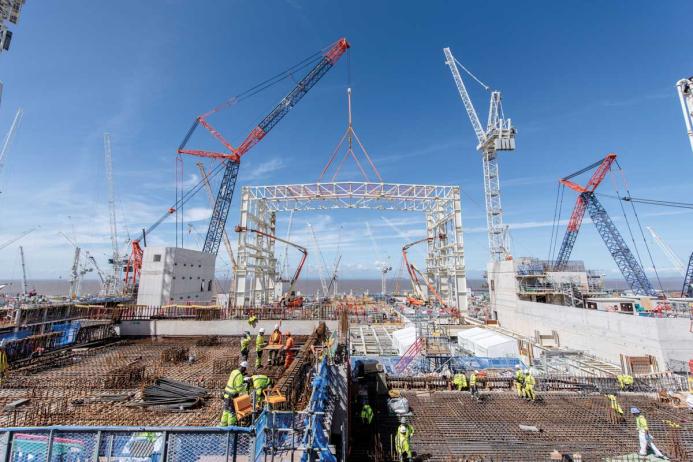The Changing Demand for Industry Materials

First published in the June 2024 issue of Quarry Management
BDS, the leading independent market research consultancy specializing in the heavy building materials and waste sectors, annually monitor the changing demand for industry materials across the construction industry. In Great Britain the heavy building materials industry includes the extraction and processing of raw materials to be used within construction projects from both land-won and marine sources. On a material level this includes output volumes for aggregates, asphalt, and concrete, and other downstream products, as well as the current and future activity of companies operating within these sectors.
The construction industry is highly sensitive to changes in the environment and market, and since 2020 material usage and demand within the sector has varied dramatically. Whilst the impacts of COVID-19 contributed towards a lasting dip in industry material production and demand, additional associated factors, including economic, social, political, and government spend, have also generated further uncertainty, negatively impacting annual volumes further throughout the construction industry.
In 2024, the markets for these products continue to face challenges, including extreme weather conditions, project delays, product and skills availability, economic growth issues, high interest rates, and inflation, all impacting the ability to meet demand within the industry. Even with the implementation of various support measures and action to help the industry from the Government, annual volumes are still not anticipated, by BDS, to recover to pre-Covid levels until at least 2025/26.
BDS produce annual industry reports and estimated output reports for all sectors of the construction industry. Within these reports are market overviews and identification of the challenges faced by the industry. An overview of this for aggregates, ready-mixed concrete, and asphalt between 2020 and 2024 is provided below, followed by a look at the key issues and developments affecting market demand from 2020 to 2024.
Aggregates (2020–2024)
In the year of the COVID-19 pandemic, the aggregates market contracted by around 12% followed by a bounce back to pre-Covid levels in 2021. In 2022, demand started to level out, however a subsequent drop in output of around 8% was experienced due to difficulties in the economic and political positioning. Since this time aggregate demand has continued to decline and even with recent announcements of new funding and realignment of existing funding, optimism in the market remains low. Furthermore, major project delays, the decline in demand for housing, and limited growth in the commercial market continue to negatively impact the use of and the need for aggregates in Great Britain in 2024.

RMX (2020–2024)
In response to the COVID-19 pandemic, the size of the ready-mixed concrete (RMX) market within Great Britain contracted by almost 16% in 2020. Whilst 2021 displayed a positive performance within the industry with annual volumes returning to near pre-pandemic levels, a later weakening in 2022 resulted in an annual decline of around 4%. In 2023 the RMX market was supported by housing plans and funds to support housing development, however the decline in housing demand continued, negatively impacting the RMX market further. Growth in the sector is anticipated to decline through 2024 before starting to return in 2025, in line with house-building growth and commencement of new construction projects.

Asphalt (2020–2024)
After the asphalt market plateaued at around 27 million tonnes in 2019, 2020 experienced a sharp decline of 8%, largely due to the impacts of the COVID-19 pandemic. 2021 saw the recovery of the asphalt market with annual volumes exceeding pre-pandemic volumes, initially increasing by 10% in 2021 and by around 2% in 2022. 2023 was a year of identifiable delays in road infrastructure projects and the cancellation of some notable large-scale programmes. This, accompanied by the stagnant housing market, generated uncertainty in the sector. Stabilization in the market commenced in late 2023/early 2024 due to the redirected HS2 funding to support the expansion of road network improvements. However, due to the extensive road improvements needed throughout Great Britain, it is still not believed this funding will stretch as far as needed to meet the full objectives. Material, labour, and production costs are continuing to increase in 2024 and this is anticipated to result in further product restrictions or materials shortages that could delay the commencement of road schemes, potentially beyond 2024.
2020
In 2020, due to the COVID-19 pandemic, the industry experienced an unprecedented six-month closure, only reopening fully with working practice operation restrictions in place for the subsequent 12 months. These limitations negatively impacted production and demand across the construction sector whilst also extending the duration of time for operations in terms of remaining reserves. The further removal of free movement of labour from Europe, following Brexit, generated a decline in staff availability that adversely affected production capacity, the supply chain, costs, and the ability to commence and fulfil much-needed construction projects.
2021
2021 was largely a bounce-back year for the construction industry with some sectors reaching near pre-pandemic annual volumes by the end of the year. The commencement and continuation of major construction projects, such as Hinkley Point C, Thames Tideway, and works on HS2, aided the increase in demand for construction materials. Within the National and Infrastructure Pipeline (NIP), published in 2021, the spending of £650 billion of public and private investment over the next 10 years was identified, including in excess of £200 billion to be spent by 2024/25. The largest proportion of spend (around £70 billion) was identified for transport projects and was to be allocated over a four-year period. Towards the end of 2021 an additional £1.8 billion was also announced to support the development of 160,000 greener homes, helped by the freeing up of brownfield sites.
2022
After a positive 2021, 2022 experienced a decline in sales across the construction industry due to the developing ‘cost of living’ crisis, stagnation in market demand, and political uncertainty. These factors, accompanied by the impending recession of 2023, increases in bank rates, doubling of inflation rates, and increases in house prices, all negatively impacted demand for construction materials across Great Britain. In late 2022, further unrest in the economy was experienced from political leader insecurity and the delivery and reversal of the mini-budget. For the aggregates sector specifically, a freeze on the Aggregates Levy was welcomed, however this was short-lived with increases being outlined less than one year later. 2022 did foresee the Government commitment to deliver £600 billion of infrastructure projects over a five-year period, however with remaining difficulties with labour shortages and materials costs, projects started to display signs of delay or in some instances cancellation. Further weakening within the housing market and failure to meet the Government target to build 300,000 new homes each year, plus the continuation of the Ukraine war, only generated a further increase in concern and industry uncertainty.
2023
In 2023 interest rates continued to climb severely, impacting housing demand by reducing the purchasing power of consumers and generating a decline in profit margins for private investors. The Government implemented a number of housing plans and schemes in 2023 to address this, including an extension to the Mortgage Guarantee Scheme, operational until June 2025, to support buyers taking out a mortgage on a 5% deposit on house purchases up to £600,000. By mid-2023 the Government released a long-term housing plan to address the current housing shortage and the provision of safe and affordable homes. The plan encompasses a series of measures to increase housing supply and regenerate inner cities and, as part of the initiative, the Government committed £800 million from the £1.5 billion Brownfield, Infrastructure and Land fund to develop up to 56,000 new homes in disused brownfield sites across England.
In line with the ‘Levelling Up’ mission plan to increase first-time buyers, the Government outlined plans to facilitate the development and regeneration of underutilized sites, such as office space and department stores, into habitable spaces nationwide. The commercial sector, including retail, office, and leisure, that had seen no growth in recent years, was also allocated £3.8 billion funding, chiefly through town-centre regeneration projects. A later amendment to the Levelling Up and Regeneration Bill in 2023 removed the requirement for developers to adhere to EU environmental regulations on nutrient neutrality when building new homes. It was believed this change could facilitate the construction of an additional 100,000 new homes between 2023 and 2030, potentially helping to boost economic growth in the UK by £18 million.
Whilst positive impacts were being made within the housing market, an increase to the Aggregates Levy was announced in late 2023, raising the rate as from April 2024 to £2.03 per tonne of aggregates. In autumn 2023 around £1.4 billion was allocated by the Department for Transport (DfT) to support the Government’s contributions to the 2020–25 Major Road Network (MRN) and Large Local Majors programme, with a further £4 billion outlined for a Phase 2 in 2025. Investment will focus on maintaining the existing road network rather than the construction of new roads. Major schemes identified to benefit include the £9 billion Lower Thames Crossing and £1.7 billion Stonehenge A3030 Improvement, however both have already faced commencement delays.
In the 2023 Budget, £200 million of funding was issued towards pothole repair for 2023/24, and in October 2023 an announcement was made cancelling Phase 2 of HS2 and a reapportionment of the £36 billion ‘saving’ to Network North. This reapportionment included the expansion of Northern Powerhouse Rail, with a further £8.3 billion allocated to improving the road network with resurfacing works for more than 5,000 miles of roads across England over the next decade. 2023 also saw the DfT pledge £1 billion roads packages in northern and southern England, respectively, as well as £650 million to the Midlands Road Fund. In 2023 work on Phase 1 of HS2 continued at pace and, along with other key projects such as Hinkley Point C and Thames Tideway, infrastructure continued to protect demand for aggregates. 2023 also detailed the Government’s continued commitment to £600 billion investment over the next five years identified in the National Infrastructure and Construction Pipeline.
2024
The start of 2024 has experienced difficulties due to weather conditions impacting work and extending timelines for construction operations. Additionally, delays and realignment of funds for existing road network projects have generated extra pressure on the construction sectors in addition to remaining difficulties with the continuing uncertainty associated with inflation, high interest rates, and low income. For the housing market, a fall in house prices in 2024, alongside a lowering of mortgage rates, may help to increase consumer affordability and help kick-start the home-buying process amongst consumers. In April 2024 the Affordable Homes Programme, providing grant funding to support the development of affordable housing, was updated. The current programme (2021–2026) aims to deliver around 180,000 new homes, with many offered at discount rent or as part of a shared home ownership programme, and defines £12.2 billion investment to meet this demand. At the start of 2024 interest rates remain high, impacting the cost of new projects, however the anticipated lowering of interest rates in the summer 2024 may help the private and industrial sectors, with consumers now choosing to spend on home improvements rather than save further, alongside the easing of financial borrowing and investment.
Previously confirmed government investment projects continue to be problematic in 2024 with many approved projects still delayed due to cost and the continuation of labour shortages. The building of new hospitals and schools is expected to increase over the forthcoming years to meet the commitment made by the Government in 2019 in the Health Infrastructure Plan and the School Rebuilding Programme, updated May 2024, but these too could face similar cost- and labour-associated delays in future months and years.
Subscribe to Quarry Management, the monthly journal for the mineral products industry, to read articles before they appear on Agg-Net.com








